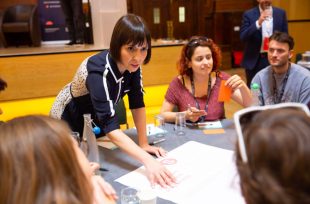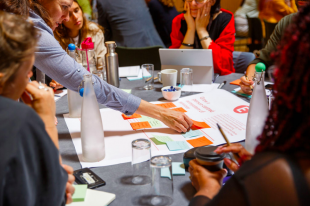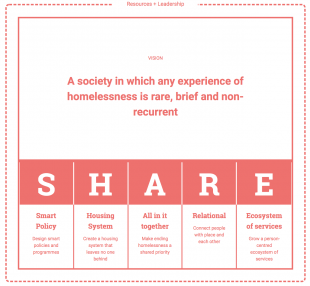
For the last 50 years, a lot of smart, well-resourced people and institutions have been trying to work out how to end homelessness in the UK and elsewhere. Millions of pounds have been invested in programmes or organisations that want to help people who are at risk of or experiencing homelessness. They have studied issues like housing, social security, employment and asset-building, and then introduced or advocated for policies and programmes to support the most at-risk groups. They've written reports and columns and given passionate speeches, decrying the fact that the weakening of our social safety net is pushing more and more people into homelessness, even though we know that prevention is better than cure.
Too many people remain without a home in the 21st century. They are not just sleeping rough on our streets, but also living in overcrowded housing, hostels and other temporary accommodation. In recent years, increased homelessness in many areas has again put a spotlight on the issue. At times like these, homelessness returns to the public’s attention, leading to renewed action and the provision of more resources. As a result, numbers go down temporarily, but in time the cycle repeats. It’s not enough to reduce the number of people affected by homelessness if we cannot sustain that change.
How can an evidence-based approach help tackle homelessness?
It is often too easy o conclude that an existing practice is effective — that we already know ‘what works’. But there might be a better way to help this patient to heal, this child to learn, or this service to innovate. In this sense, the first step to more effective policy and practice is always humility.
Homelessness is influenced by a variety of complex factors like the strength of the social safety net and the health of our families and communities. Changes to one part of the system will likely have knock-on effects on others. In homelessness people are not aware of the best ways to help end homelessness for good, and so miss opportunities to make a tremendous difference.
Addressing this requires taking a bird’s-eye view of homelessness, one that considers the bigger picture of what ending homelessness truly means. It demands a broad approach to generating and translating evidence and a better understanding of how to interpret and use this in policymaking and practice.
The Centre for Homelessness Impact, a What Works Centre for homelessness, launched in 2018 to act as a catalyst for evidence-led change to enable the field to achieve breakthrough results. We want to ensure that when we’re trying to help people we do so as effectively as possible. Our ultimate vision is to end homelessness for good and to create a society in which any experience of homelessness is rare, brief and non-recurring.

A system-level view
By 2024, we want more people who are at risk of, or experiencing homelessness to be housed in suitable homes quickly; to be financially secure; to have strong social connections; and to have a sense of agency. We are committed to building evidence about what is effective to reshape the complex system of determinants of homelessness and ensure that this informs policy and practice. To do so, our strategy adopts a three-pillared approach:
- Make evidence accessible and fill the gaps:
We will generate and synthesise evidence and address gaps in the evidence base indirectly as well as directly. We will continue to develop our flagship tools and create new ones that put reliable evidence at people’s fingertips and improve their understanding of what works and what doesn’t when it comes to ending homelessness.
In our first year we produced an Intervention Tool, which commissioners can use to explore evidence of impact and cost effectiveness for specific interventions; an Evidence Finder, which helps to quickly identify where in the world a study was conducted; and created two Evidence and Gap Maps that put evidence at people’s fingertips as well as highlight where evidence does or does not exist, what works and why. All of these informed the co-development of our research priorities agenda and informed our first three systematic reviews.
- Support data and evidence to be applied in practice
We will instil an appreciation of data and evidence and skills for their use among policymakers and practitioners, providing resources and services that teach analytical frameworks and practical skills to evaluate and use data and evidence for decision-making.
Together with the Office for National Statistics, we are developing a set of Homelessness Indicators, based on our SHARE Framework, that can be used to understand progress towards ending homelessness. We believe that to truly scale and sustain the kind of evidence-led change required, a common framework is necessary. We created SHARE in response to this need to help us take a bird’s-eye view of homelessness, ensuring we focus on what truly counts rather than just what is easy to measure. We also hope this and related data projects — such as the recently concluded options appraisal for a new data and monitoring system for street homelessness in Scotland — will contribute to ongoing efforts to improve the quality of homelessness data in the UK and beyond.

Simultaneously we are supporting local areas to improve their use of data and evidence to achieve better results for people who are at risk of or experiencing homelessness. As a first step towards growing a Community of Practice, we are currently taking three local authorities through a pilot programme through which we will help them identify a challenge and leverage existing data and evidence to design a trial to evaluate a proposed intervention. To do so, we are partnering with organisations with deep knowledge in the effective use of data (Johns Hopkins University), behavioural science (Behavioural Insights Team), and design (IDEO), to test and build solutions and inspire a culture of collaboration.
Finally, we are working on our first trials with the Behavioural Insights Team that aim to encourage landlords to let properties to people experiencing homelessness or at risk. And we will be working with government, research councils and others to ensure insights from our work help scale and guide research investments and grow a culture of experimentation so we can begin to answer ever more detailed questions about what works for whom and where. Only then will be able to make even better use of limited resources.
- Mobilise a learning culture
We will build a movement that believes that we serve all citizens better when we value evidence and know how to use it, working with professionals and communities to drive lasting change and grow a learning, creative culture.
This summer we held our very first Impact Forums across the UK, bringing together the foremost leaders from policy and practice, lived experiences and other parts of society to provide a platform for advancing evidence-led solutions to the homelessness field’s most pressing challenges, inviting delegates to openly share, collaborate and innovate. We will hold Impact Forums again next year, and offer other opportunities for individuals to connect with us and each other through meetups and online resources, our In Conversation series or initiatives like our recent Emerging Leaders Programme.
Early next year we will launch Using Evidence to End Homelessnes, an edited volume of essays and papers from a cross-party group of leaders from government, third sector and academia, which encourages those working at all levels of policy and practice to use data, evidence and evaluation to drive funding and policy decisions.
What’s next?
Adopting the strategies above will allow us to collectively make significant and long-lasting changes over time. They are all interconnected: one strategy in isolation cannot achieve the impact we need but progress on one leads to improvement in the others.
Transforming these words into a living plan that’s mirrored in day-to-day actions is not something that will happen immediately; it is taking concerted, consistent effort over time. But history shows — whether through dramatic reductions in smoking, alcohol-related traffic fatalities, or deaths from malaria — that bold goals seem impossible until they are not. And a better use of data and evidence will help us achieve them.
If you’d like to hear more about our work or are interested in collaborating, get in touch on hello@homelessnessimpact.org or tweet us at @homelessimpact.
Leave a comment